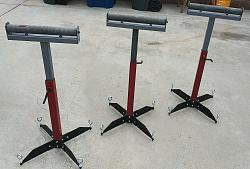has proven more than satisfactory!
I'm involved away from home, prepping my former residence for a new tenant. She'll be just the third since 2001; saying something about my landlording technique. Both prior moved only because their family size increased beyond a 2 bedroom home.
Some work naturally requires simple carpentry. Being away means make do; and feel that's been done surprisingly well.
Handling lumber on a clamp table is fine, until the weight counteracts leverage. During our dingdong 'shelter in place' recommendations, going for sawhorses was an unreal exercise in H*LL NO! So cruised instead the local online ads like craigslist. Didn't expect roller stands, let alone a set of three [favorite quantity for many things] at $50.00, and not too far away. Bought them virtually sight unseen, other than sellers admission rollers still turned, and remainder "a little rusty". But they proved immense help working alone here.
So as project winds down, I'm straightening out things one by one, in preparing to leave, which is still not soon. I have little resistance to diversion anyway.
Broke the stands down completely. Angle sanded and brushed them severely for paint. Replaced all assembly hardware, [many twisted off in disassembly]. Drilled and re-tapped all 12 frozen leveling screws, replaced with 3/8-16 eyebolts, flat washers and proper hex nut. Used up partial rattle cans, justifying extravagant tarted up paint scheme. New reality show...Pimp My Shop Material Handling Equipment?
Eyebolts, by the way aren't the worst hardware for lightweight use like this. All 12 cost far less than 2 pair of swivel pads.
Totaled, $70-$75 and ~5 hours backyard labor versus $450 + tax + shipping, and assembly.
While new stands [same brand] are $150 USD, they are fully American made with a marvelous set of features; 500 lb load capacity [!], tough powder coating, two roller positions above or lower make the frame horns guide material, independent leveling of course, and my pick as best height adjustment.
The [female] upright tube, 2"x2" is drilled through where the 1/2-13 nut welds on. The male frame is formed like channel, but fully TAPERED down towards bottom end. Even minimal pressure of the crank shaped screw does not allow male end descend further than desired. Start a little higher than needed, loosen screw and taper forces a very controllable adjustment, compared with all too common compression variety. Taper is quite slow, but perfect at roughly .6" in 20". Further tightened is more secure but does not change height.
Only apparent addition will be a leaf of stock between male frame and screw as a 'washer'. Secure tightening mars slider and then interferes with smooth adjustment.
You can produce those, sawn from square or rectangular heavy wall tube and both walls milled level & straight. A bit concave is still OK, as it provides 2 lines of contact, convex won't work well.
Once again at home base, these will be employed at the metal cutting station. 4 way level is well worth effort related to cutting, that not only height is correct, the machine base and outboard support are in the same plane. Otherwise, not so noticeable in narrow stock, creates additional machine time squaring thick, wide or long material.
I've addressed that before, when internet was so young, with resources entirely different than here. Against their original disdain for it, gets used every day.
https://www.homemadetools.net/forum/...-bandsaw-66556
There I go again, shameless self promotion.


 LinkBack URL
LinkBack URL About LinkBacks
About LinkBacks



 Reply With Quote
Reply With Quote


Bookmarks